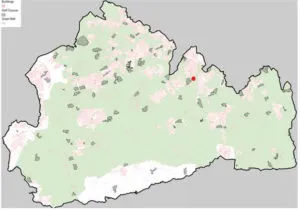Hit a bunker? How More or Less got it wrong on the golf stat
Published: by John Bibby
Avid listeners of Radio 4’s More or Less may have tuned in last week to hear their analysis of Shelter’s ‘golf stat’: the estimate that more space is dedicated in England to golf courses than houses.
In November last year, based on work by Colin Wiles, Shelter estimated that roughly 1.1% of land in England was covered by 18 hole golf courses, which is equivalent to the amount of space covered by housing. Including smaller courses and driving ranges there would, therefore, be more space dedicated to golfing than homes.
The conclusion we drew from this was that the perception that the country faces a land shortage is wrong. We have the space to build new homes and can do so if the right policies are put in place.
But More or Less’s raison d’être is to put statistics under the microscope and they were unsatisfied with an estimate (which is fair enough). As such, last week they tried to categorically determine the amount of space dedicated to golf in England.
Their results suggested that Shelter overestimated by a factor of two. In other words, More or Less found that twice as much space in England is dedicated to housing as golf.
Usually we’d take something like this on the chin – even giving half the amount of space for housing to golf is a pretty shocking stat. But on this occasion we thought we’d show how More or Less have got it wrong, in part because it makes a useful point about everyone’s favourite subject: land data transparency.
So how did More or Less come to their conclusion?
The programme calculated the amount of space used as golf courses in England with Openstreetmap, an open source piece of mapping software a bit like Google Maps. Unlike Google Maps, however, as an open source project Openstreetmap is built by a community of users who upload and maintain data. As part of this users are able to ‘tag’ land and buildings to mark them as, for example, places of worship, parking, shops or… golf courses.
In general, where large amounts of data are available and good, this makes Openstreetmap a good bit of kit. Where data is disparate or sketchy, however, it can be incomplete. This is true for golf courses.
A good example of this incompleteness can be found on the map below, which was uploaded by More or Less’s researcher and shows tagged golf courses in Surrey. The red dot (added by us) is Epsom Golf Course, a full 18 hole golf course which is not tagged on Openstreetmap. In other parts of the country, whole swathes of golf courses are missing or undersized. We found 23 with just a quick look at Cumbria and Northumberland alone.
(You can have a hunt for other missing golf courses in Surrey by checking out tagged golf courses here. You can also change the location of the search area by changing the grid references in the address bar to look at other parts of England. Download times can be large depending on the size of your search area).
To be clear, this doesn’t prove that more space is occupied by golf courses in England than houses. It just indicates than more than half is.
Which brings us back to land data transparency.
The reason that we don’t categorically know how much space in England is used as golf courses is because there is no complete and publically available data. Shelter argued with KPMG last month that data on land ownership must be published in a format that could be easily mapped. This information – combined with address data – might help us more accurately map the space used for golf.
More importantly, though, publicly available information on land prices, ownership history, options to purchase and planning permissions would provide policy makers with the tools they need to improve their local plans and negotiate better deals with developers. It would also allow local residents and would-be house builders to understand what’s really going in the land market. Without this information they are shooting in the dark.
In our view, building new homes is more important than golf. Equally, opening up land data so that we can correct failures in the land market is much more important than settling an argument about stats. It would be great to see More or Less backing this campaign for more transparency so that we can finally build the homes we need.
